The Journey of Hubble space telescope | Discoveries of Hubble space telescope | Information about Hubble space telescope
The great Hubble space telescope stands in the first place
when compared to all other telescopes ever built by humans. It entirely changed
our view towards the Universe. It revealed us the science behind the stars,
galaxies, nebulas and more by capturing images of them.
The Hubble space telescope is named after the astronomer
Edwin P. Hubble. In 19th century, astronomers assembled many ground based
telescopes to observe the Universe, but sunlight in day time and moon light,
clouds, climatic conditions in the night time effected them. Due to these reasons
astronomers got an idea to build the telescopes and send them into the space to
explore the Universe more accurately. These telescopes are called the space
observatories.
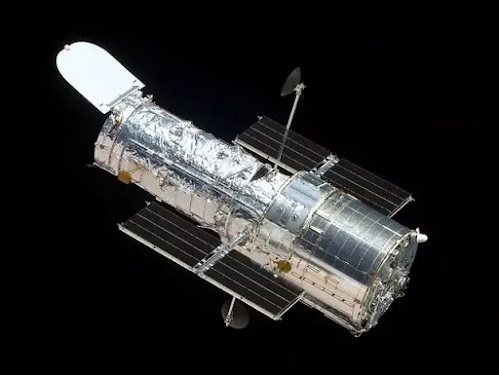 |
| Hubble_space_telescope_Into_the_dark_space Image credit: NASA |
In late 1900's, NASA in conjunction with ESA started to build
Hubble space telescope. After many difficulties, On 24 April 1990 at NASA's
Kennedy space centre this Hubble space telescope was launched.
This started the journey of the Hubble space telescope to
explore the universe for the first time. It costed NASA and ESA about 4.7
billion dollars to construction and launch.
Primarily it was launched with four basic instruments,
1. Wide field and planetary camera
2. High speed photometer
3. Faint object spectrograph
4. Faint object camera
These instruments were integrated together to observe the UV
light, Visible light and Infrared light.
After the successful launch of Hubble space telescope
scientists eagerly waited to examine the images captured by it. But scientists
were shocked to see the images captured, as they got blurred due to a small
defect while manufacturing the main mirror. The defect is so small as a 1/50
part of our hair.
"Since it is the biggest telescope every built by
humans, the defect occurred due to the complexity of the mirror used in Hubble
space telescope" NASA said.
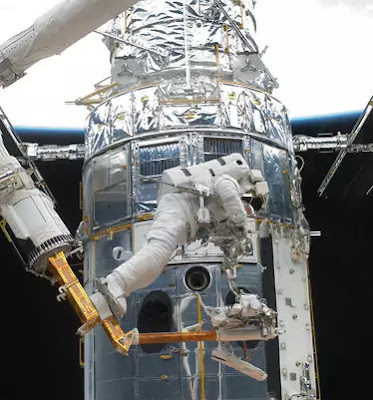 |
| Servicing_Hubble_Into_the_dark_space Image credit: NASA |
It is orbiting earth in space at about 550 kms altitude and
orbiting at a velocity of about 27,300 Kms/hour. It completes one revolution in
just 95 minutes.
Like we service the instruments that we use, NASA also
provide servicing to the Hubble space telescope since 1993.
As we know, the first ever servicing was done on 1993,
second on February 1997 replacing 2 instruments with 4 new ones. Later, the 3rd
servicing was done in two phases as 3A and 3B in the years 1999 and 2002. The
4th servicing was scheduled on 2005, but due to the Colombia disaster on 2003,
it was done on May 2009. Until now, NASA serviced the Hubble space telescope
for 4 times in the process of integrating advanced technology.
It consists of two solar panels which are 24 feet apart,
making Sun as a source of energy to run.
What it discovered?
One of major images that changed our view towards the Universe
was captured by Hubble, known as Hubble deep field & Hubble ultra-deep
field.
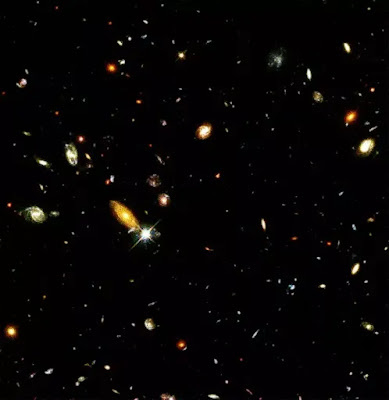 |
| Hubble_deep_field_Into_the_dark_space Image credit: NASA/JPL/STScI Hubble Deep Field Team |
The Hubble deep field is an image taken in a small part in
the constellation of Ursa Major which is for 10 days long (18 to 28 December,
1995). The region is so small as 1/20 million part of the space around us. This
image shows stars and more than 3000 galaxies which are in young stages.
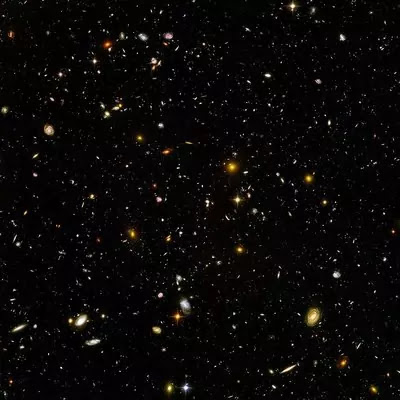 |
| Hubble_ultra_deep_field_Into_the_dark_space Image credit: NASA, ESA, S. Beckwith (STScI) and the HUDF Team |
The Hubble ultra-deep field is an image taken in a small
part in the constellation of Fornax on 24 September 2003 to 16 January 2004. Hubble
observed this region for a total of 4 months to collect data and capture this
image. It is estimated that this image has 10,000 galaxies in it. Estimations
also revealing that these galaxies in the Hubble ultra-deep field image may
have formed 0.8 billion years after big bang.
From this Hubble ultra-deep field image, extreme deep field
and ABYSS deep field images are made, by gathering some more information
through observations.
Hubble space telescope also revealed the age of the Universe
and rate of expansion of the Universe. It is possible because of the cepheid
variable stars. These stars rapidly changes size and temperatures causing the
brightness to increase or decrease. Every galaxy consists of these type of
stars, which can be tracked easily by Hubble and helps us in calculating the
distance and velocity of the galaxies.
By these calculations, scientists made some estimations
about the age of Universe, rate of expanding of Universe after the big bang and
concluded that the Universe may have an age about 13.8 billion years. Before
the launch of Hubble, scientists thought that universe may have an age about 10
to 20 billion years.
It not only studied about the galaxies but also studied
about the stars and their evolutions to know the science behind them. It also
revealed some of the interesting facts about our neighbour galaxies like
Andromeda galaxy, Magellanic clouds and more. It also taken the images of the
Exoplanets, in which the first one was captured in the year 2004 through
visible light known as Fomalhaut, is 25 light years away from Earth. Later, it
took images of the many other exoplanets too.
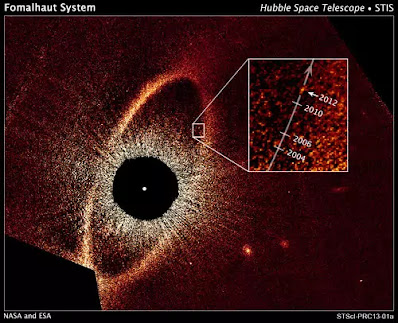 |
| Hubble_Reveals_Fomalhaut_Into_the_dark_space Image credit: NASA, ESA, and P. Kalas (University of California, Berkeley and SETI Institute) |
Through its journey until now, it also captured the high
resolution images of the different celestial objects in our own solar system.
So, we can examine them very precisely.
Until 1960's scientists thought that a super massive black
hole sits at very centre of every galaxy, later Hubble observations confirmed
it. It observed that stars at the middle of each galaxy are orbiting around an
uneven object which is not visible concluding as a super massive black hole.
On March 2019, ESA taken data about our own Milky Way galaxy
from Hubble. From this upgraded data, it is estimated that Milky Way weighs
approximately 1.5 trillion Solar mass units and has a radius of about 1,29,000
light years. Previously, it is thought to be Milky Way may weighs between 500
billion to 3 trillion times the Sun's mass.
In exploration of the Universe, Hubble played a major role
since its launch in 1990.
Until now, Hubble made more than 1.3 million observations
and recorded them on more than 15,000 papers. In which, 200 papers are
releasing to public every year.
Hubble captured many images in the Universe, including
popular images like Pillars of creation in Eagle Nebula, Crab Nebula, Orion
Nebula, NGC 1015, Galaxy clusters, tracked black holes and many more. We will
discuss them in next article.
Scientists are expecting that Hubble space telescope may
expire in between 2030 to 2040, but a new observatory which is the son of Hubble
space telescope joining the great observatories soon called "James Webb
space telescope". To know about James Webb space telescope click here.
For more information click here and for updates please follow my site,
Thank you.
Good information 👌👌
ReplyDeleteThank you.
Deletemanchi content bro....nice...
ReplyDeleteThank you bro, share.
DeleteSuper 👌👌👌
ReplyDeleteThank you.
DeleteSuper
ReplyDeleteThank you.
DeleteWow
ReplyDeleteThank tou, keep sharing.
DeleteWoww
ReplyDeleteThank you, share.
Deletesuperb bro
ReplyDeleteThank you bro.
DeleteVery informative.
ReplyDeleteThank you, keep sharing.
Delete☺️☺️☺️
ReplyDeleteHaha, Thank you.
DeleteAwesome😍
ReplyDeleteThank you.
DeleteThank you bro.
ReplyDeleteThank you, keep sharing.
ReplyDeleteGood topics, interesting 😍.
ReplyDeleteGood collective work
ReplyDelete